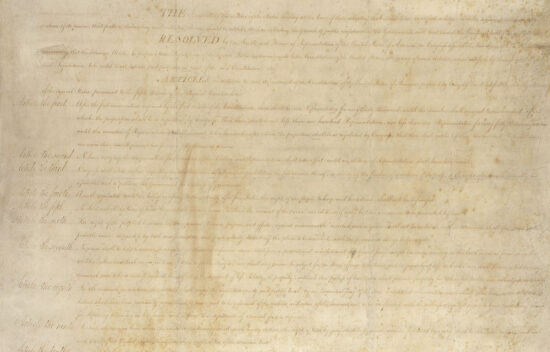
Why A Bill of Rights? What Impact Does It Have?
45 min
Objectives
- Students will explain the arguments of the Federalists and Anti-Federalists regarding a bill of rights.
- Students will identify continuing controversies regarding appropriate powers of government versus individual rights.
- Students will, with respect to civic participation, analyze the ongoing implications of Federalist and Anti-Federalist positions.
- Students will participate in civil discourse concerning the Bill of Rights.
- Divide students into pairs or trios and ask them to share their Handout B chart responses and compare their answers.
- Have each group identify which argument they feel is strongest for each heading: Federalists and Anti-Federalists.
- Give each group a copy of Handout C: Federalists and Anti-Federalists Venn Diagram, instructing them to complete the Venn diagram using key words to record the positions of the Federalists and Anti-Federalists.
- Go over the Venn diagrams as a class, and answer any questions.
- As a class, discuss whether students think they would have sided with the Federalists or the Anti-Federalists in the debate over the Bill of Rights.
Ask students about a time when they either experienced their own rights being abridged, or witnessed this happen to someone else. What was, or what should be, the reaction of other individuals to the abridgment of rights? What was, or should be, the government’s role in protecting everyone’s rights?
- Split the class into two groups, “Federalists” and “Anti-Federalists”. Have the students write a few short paragraphs (homework) or have small-group debates (in-class) answering the following questions according to whether they are Federalist or Anti-Federalist:
- What is the ideal form of government?
- Should a bill of rights be added to the Constitution?
- Have students choose one of the rights protected by the Bill of Rights and find 2-3 recent news articles relating to that right. Have students summarize the articles and answer the following questions:
- Is this a natural right?
- Why did the Founders include this right in the Bill of Rights?
- How has the way we understand this right changed over time?
- Have students choose one of the rights protected by the Bill of Rights and ask their parents, friends, or family what that right means to them. Have students summarize these interviews and then answer the following questions:
- Is this a natural right?
- Why did the Founders include this right in the Bill of Rights?
- Would the Founders agree with the way we interpret this right today? Why or why not?
Student Handouts
Next Lesson